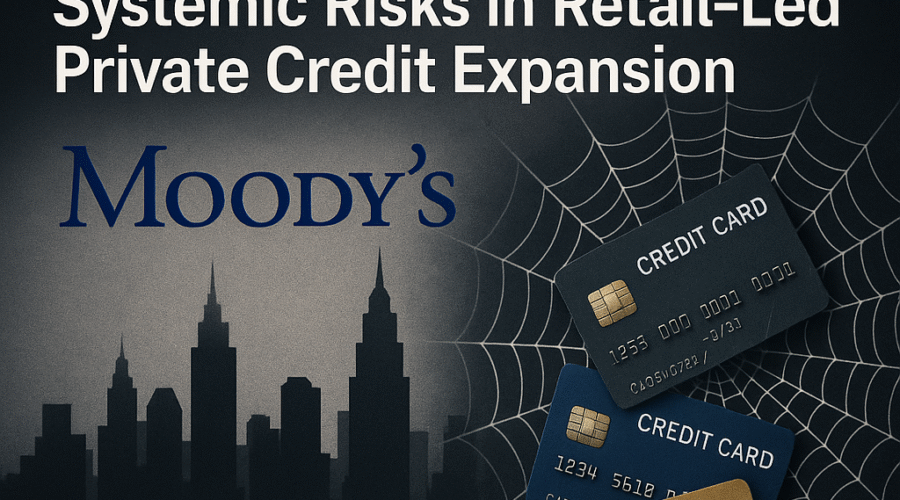As retail capital floods into private credit markets at unprecedented rates, Moody’s Investors Service has issued a stark warning about emerging liquidity mismatches and deteriorating underwriting standards[9][10][16]. The $2.1 trillion private credit sector now faces its first true stress test since becoming a mainstream asset class, with retail investors projected to account for 25% of total AUM by 2026[12][16]. This tectonic shift from institutional dominance to retail participation through vehicles like evergreen funds and private credit ETFs creates complex risk vectors that could destabilize corporate lending markets during periods of financial stress[11][15][18].
💼 Seasoned CorpDev / M&A / PE expertise
The Retail Onslaught: Democratization or Destabilization?
Channeling Main Street Capital Into Private Markets
Private credit AUM has grown at a 17% CAGR since 2020, fueled by retail inflows through three primary conduits[2][5][12]:
| Vehicle | AUM Growth (2023-2025) | Liquidity Terms |
|---|---|---|
| Business Development Companies (BDCs) | 71% to $195B | Quarterly redemptions with 5% gates |
| Private Credit ETFs | First launched 2024 | Daily liquidity |
| Evergreen Funds | 89% CAGR since 2022 | Monthly subscriptions/redemptions |
This structural shift mirrors the pre-2008 CDO boom, with 46% of BDC assets now held in perpetual-life vehicles targeting mass affluent investors[18]. Moody’s analysts note that retail capital now drives 60% of net new inflows to private credit funds, compared to just 12% pre-pandemic[16].
The Liquidity Mirage
While new fund structures promise daily or monthly liquidity windows, the underlying assets remain fundamentally illiquid corporate loans with 5-7 year maturities[7][19]. This creates dangerous asymmetry – during the March 2025 rate spike, Ares Capital’s NAV dropped 14% while its shares traded at a 27% discount, forcing $2.4B in asset sales to meet redemption requests[11][18].
Four Emerging Risk Vectors
1. Covenant Erosion & Zombie Company Proliferation
63% of 2024-vintage private credit deals were covenant-lite, up from 41% in 2020[2][12]. Combined with rising PIK (payment-in-kind) debt now comprising 18% of portfolios, this creates systemic exposure to non-viable borrowers[11][16]. Moody’s estimates 22% of current private credit exposure is to companies unable to service debt through operating cash flows[12].
2. Regulatory Arbitrage Time Bomb
The SEC’s 2024 Private Markets Enhancement Act exempted private credit ETFs from 1940 Act requirements, allowing daily liquidity for assets that typically trade quarterly at best[11][15]. This regulatory gap has enabled $47B in retail-focused products with duration profiles mismatched to investor expectations[16][18].
3. Bank Backdoor Contagion
Major banks have extended $580B in credit lines to private credit funds – equivalent to 14% of total US commercial lending[11][17]. A 20% default scenario would erase 38% of Tier 1 capital at regional banks, recreating SVB-style contagion risks[17][19].
4. Insurance Sector ALM Crisis
Life insurers now hold 9% of assets in private credit, up from 2% in 2020, despite liability durations averaging 12 years versus 4.7 years for private credit holdings[12][19]. This duration mismatch could force $140B in forced sales if rates spike 200bps[12].
The Regulatory Crossroads
The Trump administration’s 2025 Capital Formation Agenda prioritizes private market growth over transparency, shelving proposed SEC rules on:
“Mandatory loan-level reporting (shelved), stress testing requirements (delayed until 2027), and liquidity coverage ratios for BDCs (under review)”[12][15][16]
This deregulatory push contrasts with EU moves to implement Basel IV standards for private credit, including 8% capital buffers on fund financing lines[19]. The lack of global coordination creates arbitrage opportunities that could concentrate risk in US markets[11][14].
Defensive Strategies for Institutional Investors
1. Covenant Quality Scoring
Top-tier managers like KKR now use AI-driven covenant scoring models that analyze 147 legal and financial parameters, rejecting 68% of deals that fail minimum protection thresholds[3][12].
2. Liquidity Tiering
Blue Owl Capital’s 2025 fund structure segments portfolios into:
| Tier | Assets | Liquidity Profile |
|---|---|---|
| 1 | Senior secured loans | 90-day liquidity |
| 2 | PIK toggle notes | 180-day gates |
| 3 | Equity co-investments | 3-year lockup |
3. Regulatory Beta Positioning
With 83% probability of Democratic regulatory reversal post-2028 election[12], forward-looking funds are:
“Pre-emptively adopting EU-style liquidity buffers, increasing portfolio transparency, and capping retail allocations at 15% of total AUM”[11][16][19]
The Road Ahead: Crisis or Correction?
While private credit’s 9.2% average annual return remains attractive versus public fixed income[6][8], the sector’s risk profile has fundamentally shifted. Institutional investors must now navigate:
- 75% correlation between BDC flows and retail investor sentiment[18]
- $2.3T in maturities through 2027, with 38% needing refinancing[5][12]
- Potential 40% NAV declines in stress scenarios[11][19]
As Moody’s concludes: “The private credit ecosystem’s ability to absorb retail capital while maintaining discipline will determine whether this becomes a sustainable asset class or the next systemic crisis”[12][16].
Sources
https://www.moonfare.com/pe-masterclass/private-credit, https://en.wikipedia.org/wiki/Private_credit, https://www.kkr.com/alternatives-unlocked/private-credit, https://www.areswms.com/accessares/primer/understanding-private-credit, https://www.morganstanley.com/im/en-us/individual-investor/insights/articles/private-credit-outlook-2025-opportunity-growth.html, https://www.cambridgeassociates.com/insight/private-credit-markets-are-growing-in-size-and-opportunity/, https://alterdomus.com/insight/private-vs-public-credit/, https://percent.com, https://economictimes.indiatimes.com/markets/stocks/news/moodys-flags-risks-as-retail-investors-flood-private-credit/slideshow/121769009.cms, https://economictimes.indiatimes.com/markets/stocks/news/moodys-flags-risks-as-retail-investors-flood-private-credit/slideshow/121768990.cms, https://www.ainvest.com/news/retail-investment-surge-private-credit-systemic-risk-timebomb-2506/, https://www.moodys.com/web/en/us/insights/credit-risk/outlooks/private-credit-2025.html, https://heronfinance.com/blog/how-to-invest-in-private-credit-funds-for-retail-investors/, http://www.moodys.com/web/en/us/insights/credit-risk/outlooks/credit-risks-for-2025.html, https://economictimes.com/markets/stocks/news/moodys-flags-risks-as-retail-investors-flood-private-credit/slideshow/121768990.cms, https://www.nationthailand.com/business/economy/40049746, https://www2.deloitte.com/us/en/insights/industry/financial-services/alternative-lending-effect-on-banks.html, https://know.creditsights.com/us-private-credit-weekly-retail-bdc-money-could-create-challenges-amid-tough-deal-backdrop/, https://www.elibrary.imf.org/display/book/9798400257704/CH002.xml





